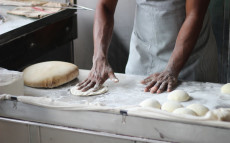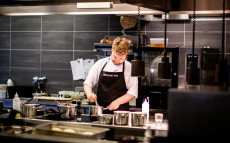- pathfindersAI
- Job Profile
Cooks, Institution and Cafeteria
Summary
Job Description: Cooks, Institution and Cafeteria
What They Do
Cooks, Institution and Cafeteria, are the unsung heroes of the food service industry. They prepare large quantities of meals for institutions such as schools, healthcare facilities, corporations, and correctional facilities. This is not just ordinary cooking; these professionals ensure that the food is nutritious, appealing, and meets the specific dietary guidelines relevant to the particular institution. Their work impacts the daily lives of countless individuals, enabling them to thrive by providing well-balanced meals.
Job Responsibilities
The responsibilities of Cooks, Institution and Cafeteria, are multifaceted and vital to the daily operations of their respective establishments. Foremost among their tasks is meal preparation, which includes everything from chopping and mixing ingredients to cooking and serving food. They must follow standardized recipes to maintain consistent quality and meet nutritional requirements. In addition to cooking, these professionals are responsible for maintaining a clean and organized kitchen environment, which involves sanitizing workstations, managing waste, and adhering to health and safety regulations. Inventory management is another critical aspect of the job, where cooks must track supplies, order ingredients, and ensure that stock levels are maintained. Additionally, they often collaborate with dietitians and nutritionists to plan menus that cater to the specific needs of their clientele, whether that means low-sodium options for hospital patients or allergen-free choices for schoolchildren.
Essential Skills
To excel as a Cook, Institution and Cafeteria, a specific set of skills is indispensable. Chief among these is culinary expertise, which involves the fundamental knowledge of cooking techniques, ingredient pairings, and proper food handling. Organizational skills are crucial for managing multiple tasks simultaneously, such as preparing different dishes at various stages of their cooking process while keeping track of inventory and adhering to hygiene standards. Attention to detail ensures that every meal adheres to dietary guidelines and maintains a high standard of quality. In addition, time management skills are essential for preparing and serving meals within set timeframes, often under significant pressure. Effective communication abilities are also important, as these cooks often work as part of a larger team and need to convey instructions and collaborate efficiently.
Educational Pathways
The path to becoming a Cook, Institution and Cafeteria, typically begins with a high school diploma or equivalent, followed by vocational training or certification in culinary arts. Many institutions offer specialized programs that include coursework in nutrition, culinary techniques, and food safety. Some aspiring cooks may choose to pursue an associate degree in culinary arts, which provides more comprehensive training and better job prospects. Additionally, hands-on experience is invaluable; many begin their careers in entry-level positions within kitchens to gain practical skills. Advanced training or certification from recognized bodies, such as the American Culinary Federation (ACF), can further enhance career opportunities and demonstrate a commitment to the profession.
Career Prospects
The career prospects for Cooks, Institution and Cafeteria, are promising due to the increasing demand for quality food service across various institutional settings. According to the Bureau of Labor Statistics, employment in this field is projected to grow steadily over the next decade. As healthcare, education, and corporate sectors expand, the need for skilled cooks in institutions will remain robust. Experienced cooks with specialized training or certification may advance to supervisory or managerial roles, overseeing kitchen operations and staff. Additionally, opportunities for further specialization, such as in dietary management or large-scale catering, can open new career avenues.
Conclusion
In conclusion, Cooks, Institution and Cafeteria, play a critical role in the food service industry by ensuring that large groups receive nutritious and well-prepared meals. Their responsibilities extend beyond mere cooking to include kitchen management, collaboration with dietitians, and adhering to stringent health standards. Essential skills for this career encompass culinary expertise, organizational abilities, attention to detail, and strong time management. While the educational pathway may start with basic culinary training, advanced certifications and experience significantly enhance job prospects. The future remains bright for this profession, with steady demand and opportunities for advancement ensuring it remains a vital and rewarding career choice.
Video
Compensation
| State | Median Salary | Median Hourly | Positions |
|---|---|---|---|
| KS | 29,630 | 14.25 | 6,710 |
| KY | 29,490 | 14.18 | 12,020 |
| LA | 27,940 | 13.43 | 4,350 |
| ME | 37,950 | 18.24 | 2,280 |
| MD | 38,330 | 18.43 | 4,020 |
| MA | 46,390 | 22.31 | 8,100 |
| MI | 34,120 | 16.40 | 11,360 |
| MN | 38,910 | 18.71 | 8,140 |
| MS | 22,970 | 11.04 | 6,290 |
| MO | 29,150 | 14.02 | 15,840 |
| MT | 34,940 | 16.80 | 2,130 |
| NE | 33,680 | 16.19 | 4,750 |
| NV | 37,900 | 18.22 | 1,510 |
| NH | 39,840 | 19.15 | 1,950 |
| NJ | 42,160 | 20.27 | 7,110 |
| NM | 31,870 | 15.32 | 3,830 |
| NY | 40,910 | 19.67 | 15,870 |
| NC | 33,630 | 16.17 | 10,540 |
| ND | 37,340 | 17.95 | 2,660 |
| OH | 35,110 | 16.88 | 23,320 |
| OK | 27,300 | 13.13 | 11,440 |
| OR | 39,390 | 18.94 | 6,300 |
| PA | 35,990 | 17.30 | 20,980 |
| RI | 44,220 | 21.26 | 1,100 |
| SC | 30,120 | 14.48 | 7,690 |
| SD | 33,980 | 16.34 | 2,100 |
| TN | 29,990 | 14.42 | 12,000 |
| TX | 31,320 | 15.06 | 39,230 |
| UT | 36,410 | 17.50 | 4,700 |
| VT | 37,140 | 17.86 | 1,480 |
| VA | 36,320 | 17.46 | 11,140 |
| WA | 46,610 | 22.41 | 11,620 |
| WV | 28,440 | 13.68 | 4,270 |
| WI | 36,230 | 17.42 | 9,970 |
| WY | 34,870 | 16.76 | 1,510 |
| AL | 23,600 | 11.35 | 8,640 |
| AK | 45,520 | 21.89 | 1,440 |
| AZ | 37,910 | 18.23 | 6,370 |
| AR | 28,580 | 13.74 | 7,260 |
| CA | 44,940 | 21.60 | 24,260 |
| CO | 38,410 | 18.47 | 8,820 |
| CT | 44,820 | 21.55 | 3,910 |
| DE | 41,940 | 20.16 | 2,500 |
| DC | 43,200 | 20.77 | 1,500 |
| FL | 34,390 | 16.53 | 20,730 |
| GA | 33,310 | 16.01 | 6,660 |
| HI | 43,490 | 20.91 | 990 |
| ID | 32,550 | 15.65 | 3,610 |
| IL | 35,560 | 17.10 | 20,580 |
| IN | 32,130 | 15.45 | 11,170 |
| IA | 32,930 | 15.83 | 8,880 |
Similar Occupations
In this area you will find other occupations that are close to the one you were viewing in tasks, knowledge and work environment. If the primary job profile you are viewing isn't quite to your liking, take a look around and see what else is available.
Basic and Premium Accounts have more alternative occupations available than the Free account.

Bakers - 51-3011.00
A baker prepares and bakes various types of breads, pastries, and other baked goods by mixing ingredients, kneading dough, and monitoring baking times and temperatures. They often work early hours to ensure fresh products are available for customers each day.
-
$34,950/yr
Median Pay -
220,230
Number of Jobs

Chefs and Head Cooks - 35-1011.00
Chefs and Head Cooks oversee the preparation, seasoning, and cooking of food, ensuring that dishes meet high standards of quality and presentation. They manage kitchen staff, plan menus, and maintain inventory to ensure a smooth and efficient culinary operation.
-
$58,920/yr
Median Pay -
172,370
Number of Jobs